Urban farming is becoming an essential solution for providing fresh, local produce in densely populated areas. With the rising cost of food and increasing concerns about food security, many city dwellers are turning to urban gardening to ensure they have access to healthy and affordable food. Whether you’re working with a small balcony, a rooftop, or a community garden plot, these top ten gardening solutions will help you succeed in your urban farming endeavors.
1. Container Gardening
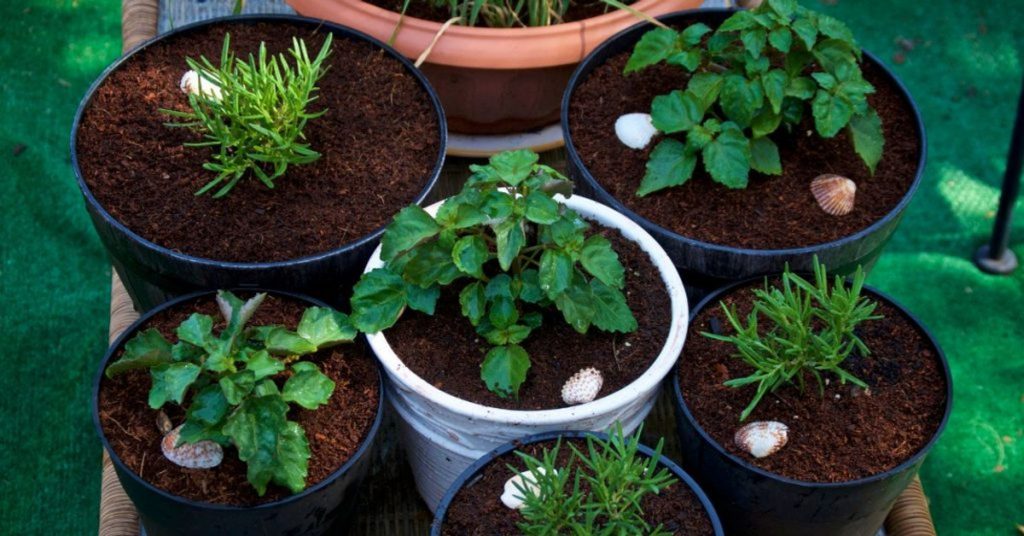
Container gardening is an excellent solution for urban farmers who often face limited space for traditional gardening. By utilizing containers, urban gardeners can transform small spaces like balconies, rooftops, and windowsills into productive gardening areas. Here’s how to maximize your container garden and make the most out of your urban space.
Benefits of Container Gardening
Space Efficiency
- Versatility: Containers can be placed almost anywhere, making them ideal for urban settings where ground space is scarce.
- Mobility: Containers can be moved to follow the sun or to protect plants from extreme weather conditions.
- Vertical Gardening: Utilize vertical space with hanging baskets, wall-mounted planters, or tiered plant stands to grow more in a limited area.
Plant Health and Maintenance
- Controlled Environment: Containers allow you to control soil quality, moisture levels, and prevent soil-borne diseases.
- Accessibility: Elevated containers reduce the need for bending and kneeling, making gardening more accessible for people with mobility issues.
Choosing the Right Containers
Size and Material
- Size: Select containers that are large enough to support the root system of your plants. Deeper pots are ideal for root vegetables and larger plants like tomatoes, while shallow pots are perfect for herbs and leafy greens.
- Material: Containers come in various materials including plastic, terracotta, and fabric. Plastic pots are lightweight and retain moisture well, terracotta pots are breathable but can dry out quickly, and fabric pots provide excellent drainage and air circulation.
Drainage
- Ensure your containers have drainage holes to prevent waterlogging, which can lead to root rot. If your containers don’t have holes, consider drilling some or using a layer of gravel at the bottom to improve drainage.
2. Raised Bed Gardens
Raised bed gardens offer urban farmers a practical solution for overcoming common challenges associated with urban soil, such as poor quality and contamination. By elevating the garden bed, you can control the soil environment more effectively, improve drainage, and reduce soil compaction. Raised beds also make gardening more accessible, reducing the physical strain of bending and kneeling. Here’s how to maximize the benefits of raised bed gardening.
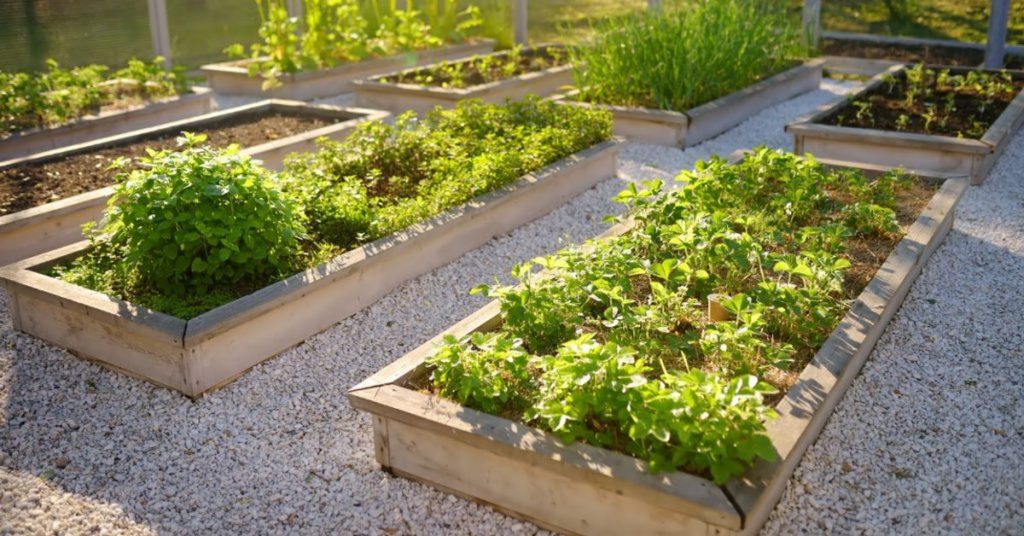
Benefits of Raised Bed Gardening
Improved Soil Quality
- Control Over Soil Composition: Raised beds allow you to fill the garden area with high-quality soil, tailored to the needs of your plants. This is particularly beneficial in urban areas where the existing soil may be contaminated or of poor quality.
- Nutrient-Rich Environment: By mixing topsoil with compost and other organic matter, you create a nutrient-rich environment that promotes healthy plant growth.
Enhanced Drainage
- Better Water Management: Raised beds offer superior drainage compared to in-ground gardens, preventing waterlogging and root rot. This is crucial in urban settings where heavy rainfall can lead to poor drainage.
- Customizable Watering: You can easily adjust the soil mix to improve water retention or drainage, depending on the needs of your plants.
Reduced Soil Compaction
- No Walking on Beds: With designated pathways around the beds, there is no need to walk on the soil, preventing compaction and allowing roots to grow freely.
- Looser Soil Structure: The soil in raised beds remains loose and aerated, facilitating better root development and nutrient uptake.
Accessibility
- Easier on the Back and Knees: Raised beds reduce the need to bend or kneel, making gardening more accessible for individuals with mobility issues.
- Customizable Heights: You can build raised beds at various heights to suit your needs, ensuring comfortable gardening for people of all ages and abilities.
Building and Filling Raised Beds
Materials
- Durable Options: Use untreated wood, stone, or recycled materials to construct your raised beds. Avoid pressure-treated wood, which can leach harmful chemicals into the soil.
- Size Considerations: Aim for a width of 3-4 feet to allow easy access from both sides. The length can vary based on available space, and the height can range from 6 inches to 3 feet, depending on your preference.
Filling the Beds
- Soil Mix: Fill your raised beds with a blend of topsoil, compost, and other organic matter. A recommended ratio is 60% topsoil, 30% compost, and 10% organic amendments like peat moss or perlite.
- Layering: For deeper beds, consider a lasagna layering approach, alternating layers of organic material and soil to create a rich, well-draining environment.
Mulching
- Benefits: Mulch helps retain moisture, suppress weeds, regulate soil temperature, and add organic matter as it decomposes.
- Application: Apply a 2-4 inch layer of organic mulch such as straw, shredded leaves, or wood chips around your plants, avoiding direct contact with plant stems.
3. Rooftop Gardening
Rooftop gardening is a creative and efficient solution for urban farmers, transforming underused rooftop spaces into productive agricultural areas. This approach maximizes available space in densely populated urban areas where ground-level gardening options are limited.
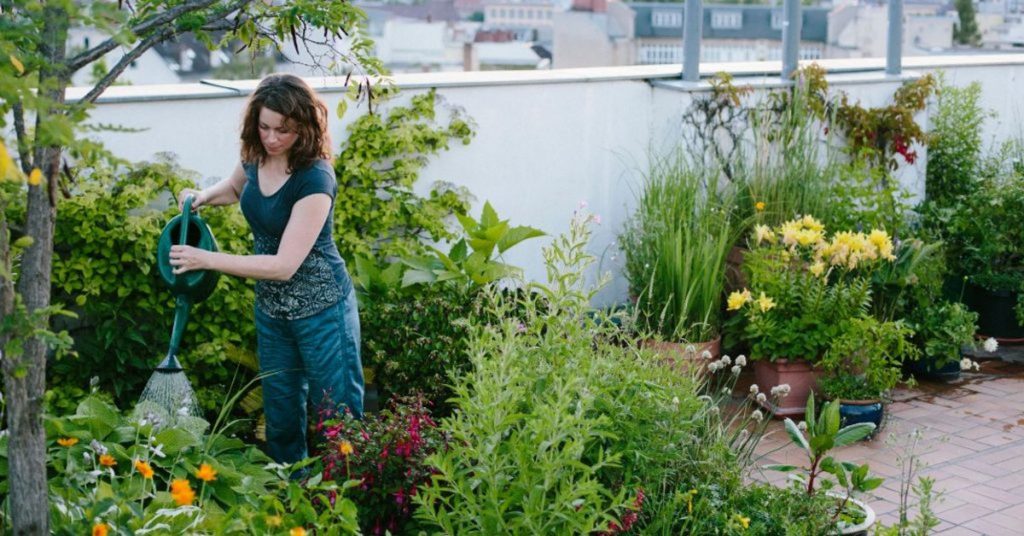
Benefits of Rooftop Gardening
Maximizing Space
- Utilizing Unused Areas: Rooftops, often neglected, can be transformed into productive gardens, making use of space that would otherwise go unused.
- Expanding Green Spaces: Rooftop gardens add green spaces to urban environments, contributing to the overall aesthetic and ecological health of the area.
Ample Sunlight
- Optimal Sun Exposure: Rooftops typically receive unobstructed sunlight, ideal for growing a wide range of vegetables, herbs, and even small fruit trees. This abundant light ensures that plants can photosynthesize effectively, leading to healthier and more productive growth.
Urban Heat Island Mitigation
- Cooling Effect: Plants on rooftops can help reduce the urban heat island effect, cooling the surrounding air and lowering energy costs for the building.
- Improved Air Quality: Rooftop gardens can improve air quality by absorbing pollutants and producing oxygen.
Planning Your Rooftop Garden
Structural Considerations
- Weight Capacity: Before starting a rooftop garden, ensure that the building’s structure can support the additional weight of the garden. Consult a structural engineer to assess load-bearing capacities.
- Lightweight Materials: Use lightweight containers and soil mixes to reduce the load on the roof. Containers made of plastic or fabric are lighter than those made of ceramic or concrete. Lightweight soil mixes, often a blend of peat, perlite, and compost, are ideal for rooftop gardens.
Waterproofing and Drainage
- Waterproofing: Proper waterproofing is crucial to prevent water damage to the building. Install a waterproof membrane to protect the roof structure.
- Drainage Systems: Ensure adequate drainage to avoid water pooling and potential structural damage. Use containers with drainage holes and consider installing a drainage mat or system to channel excess water away from the garden area.
Wind Protection
- Windbreaks: Rooftops are exposed to strong winds, which can damage plants. Install windbreaks such as trellises, screens, or taller plants to shield more delicate plants from wind.
- Sturdy Containers: Use sturdy, heavy containers that are less likely to tip over in strong winds.
Plant Selection and Maintenance
Suitable Plants
- Vegetables and Herbs: Tomatoes, peppers, lettuce, spinach, basil, and mint are excellent choices for rooftop gardens due to their adaptability and sunlight requirements.
- Small Fruit Trees: Dwarf varieties of fruit trees, such as apple or cherry trees, can thrive in large containers on rooftops.
- Native Plants: Consider incorporating native plants that are well-adapted to local climate conditions and require less maintenance.
Irrigation
- Efficient Watering: Install an efficient irrigation system, such as drip irrigation, to ensure consistent watering without overburdening the roof structure with excess water weight.
- Self-Watering Containers: Use self-watering containers to maintain soil moisture levels, reducing the frequency of watering.
Community Engagement
Collaborative Efforts
- Community Gardens: Rooftop gardens can serve as community gardens, bringing together residents to cultivate and maintain the space collaboratively.
- Educational Opportunities: Use the garden as an educational tool to teach urban residents about sustainable gardening practices and the benefits of growing their own food.
Rooftop gardening is an innovative solution for urban farmers looking to utilize underused spaces and create productive agricultural areas. By carefully planning and implementing lightweight, efficient systems, urban gardeners can transform rooftops into thriving gardens that provide fresh produce, improve air quality, and contribute to a greener urban environment. With proper planning and maintenance, rooftop gardens can become a cornerstone of urban agriculture, offering numerous benefits to individuals and communities alike.
4. Hydroponics and Aquaponics
Hydroponics and aquaponics are innovative gardening solutions for urban farmers, allowing them to grow plants without soil. These systems are particularly advantageous in urban environments where space is limited, and traditional soil-based gardening is impractical.
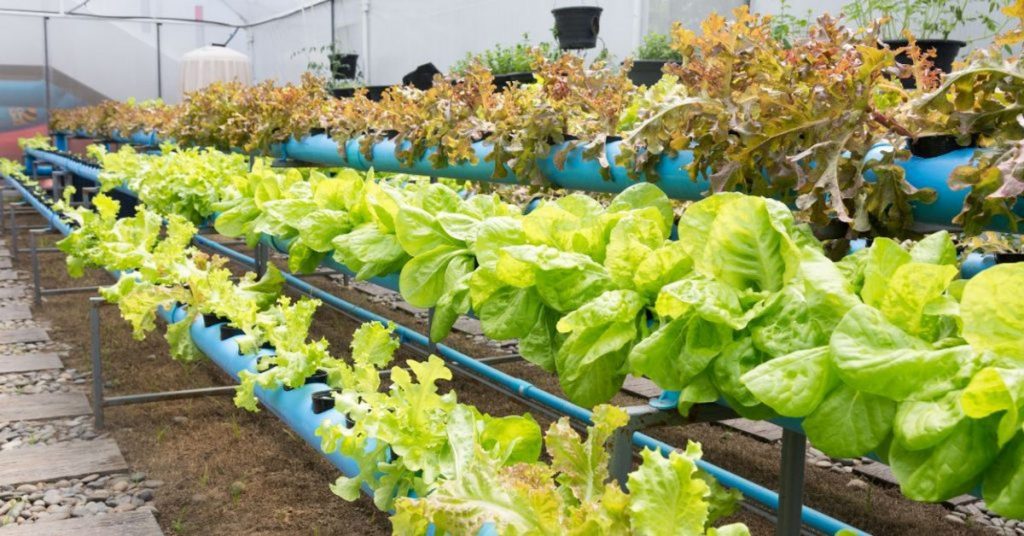
Understanding Hydroponics
What is Hydroponics? Hydroponics is a method of growing plants in a nutrient-rich water solution without the use of soil. Plants are supported in inert mediums like clay pellets, perlite, or rock wool, which provide stability while their roots absorb nutrients directly from the water.
Benefits of Hydroponics
- Space Efficiency: Hydroponic systems can be set up in small spaces, including indoors and on rooftops. Vertical hydroponic systems further maximize space by stacking plants.
- Water Conservation: Hydroponics uses up to 90% less water than traditional gardening since the nutrient solution is recirculated, reducing waste.
- Faster Growth and Higher Yields: Plants grown hydroponically often mature faster and yield more because they receive optimal nutrients directly to their roots.
- Fewer Pests and Diseases: Growing plants without soil reduces the risk of soil-borne pests and diseases.
Understanding Aquaponics
What is Aquaponics? Aquaponics is a hybrid system that combines hydroponics with aquaculture, the practice of raising fish. In an aquaponic system, fish waste provides organic nutrients for the plants, and the plants help filter and clean the water for the fish. This creates a symbiotic environment where both plants and fish thrive.
Benefits of Aquaponics
- Dual Production: Aquaponics allows urban farmers to produce both vegetables and fish, providing a source of protein and fresh produce.
- Natural Fertilization: Fish waste acts as a natural fertilizer for the plants, eliminating the need for synthetic fertilizers.
- Sustainable System: Aquaponics mimics natural ecosystems, making it a sustainable and environmentally friendly gardening method.
- Efficient Water Use: Similar to hydroponics, aquaponics uses significantly less water than traditional gardening, with the added benefit of water recycling between fish tanks and plant beds.
Setting Up Hydroponic and Aquaponic Systems
Starting Small
- Hydroponic Kits: For beginners, starting with a small hydroponic kit is recommended to learn the basics. These kits often include everything needed, such as a water reservoir, nutrient solution, grow lights, and support structures.
- Aquaponic Kits: Similarly, small aquaponic kits are available that come with fish tanks, plant beds, and pumps. These kits are ideal for learning how to balance fish and plant care.
Scaling Up
- DIY Systems: Once comfortable with the basics, urban farmers can build custom hydroponic or aquaponic systems tailored to their specific needs and available space. This can involve creating larger plant beds, adding more grow lights, and integrating automated systems for nutrient delivery and water circulation.
- Commercial Systems: For those looking to expand significantly, commercial hydroponic and aquaponic systems are available. These systems are designed for higher productivity and can support a wider variety of plants and fish.
Maintenance and Care
Regular Monitoring
- Nutrient Levels: In hydroponics, maintaining the correct nutrient balance in the water is crucial. Regularly test and adjust nutrient concentrations to ensure plants receive the essential elements they need.
- Water Quality: In aquaponics, monitor water quality parameters such as pH, ammonia, and nitrate levels to maintain a healthy environment for both fish and plants.
Lighting
- Artificial Lighting: Use grow lights to supplement natural sunlight, especially in indoor setups or during seasons with limited daylight. LED grow lights are energy-efficient and effective for plant growth.
Pest and Disease Management
- Integrated Pest Management (IPM): Employ IPM strategies to manage pests and diseases. This includes regular inspection, biological controls, and maintaining a clean growing environment.
Hydroponics and aquaponics offer urban farmers versatile and efficient gardening solutions, allowing them to grow fresh produce and fish in limited spaces without soil. These systems are ideal for maximizing productivity, conserving water, and providing a sustainable approach to urban agriculture. By starting with small kits and gradually scaling up, urban farmers can successfully integrate hydroponics and aquaponics into their gardening practices.
5. Community Gardens
Community gardens offer a practical and social solution for urban farmers. By sharing resources and space, these gardens provide a supportive environment for growing food and fostering a sense of community. Here’s how community gardens can benefit urban farmers and how to get involved.
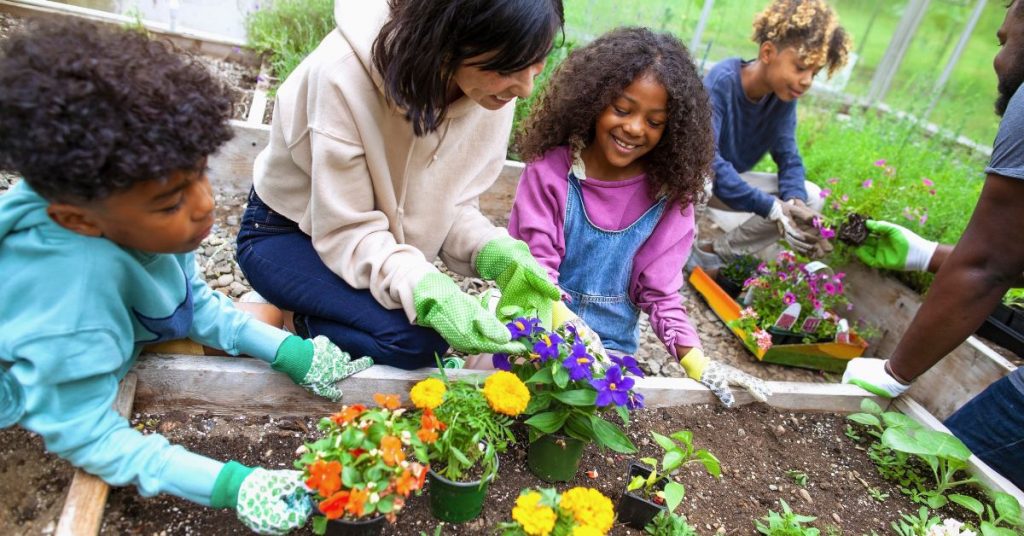
Benefits of Community Gardens
Shared Resources
- Tools and Equipment: Community gardens typically provide access to shared tools and gardening equipment, reducing the need for individual purchases. This can include items like hoes, shovels, watering cans, and wheelbarrows.
- Soil and Compost: Many community gardens have communal composting systems and high-quality soil amendments available to all members, ensuring that everyone has access to nutrient-rich growing mediums.
Knowledge and Expertise
- Learning Opportunities: Community gardens are excellent places to learn from more experienced gardeners. Workshops, demonstrations, and informal advice can help beginners improve their gardening skills.
- Problem Solving: When issues like pests or diseases arise, having a community of gardeners to consult can lead to faster and more effective solutions.
Social Benefits
- Community Building: Gardening alongside neighbors fosters a sense of community and cooperation. Shared goals and collective efforts strengthen neighborhood bonds.
- Mental and Physical Health: Participating in community gardening provides physical exercise and stress relief, contributing to better overall health and well-being.
Getting Started with Community Gardening
Finding a Community Garden
- Local Resources: Check with local government offices, community centers, or online platforms to find community gardens in your area. Many cities and towns have directories of available garden spaces.
- Gardening Associations: Organizations such as the American Community Gardening Association (ACGA) provide resources and listings for community gardens across North America.
Joining a Community Garden
- Membership: Most community gardens require a membership or plot rental fee. These fees often go towards maintaining the garden and providing communal resources.
- Rules and Guidelines: Familiarize yourself with the garden’s rules, including planting schedules, maintenance responsibilities, and shared work duties. Adhering to these guidelines ensures the garden remains a productive and pleasant space for everyone.
Contributing to the Garden
- Volunteer: Volunteer for garden projects and maintenance tasks. This could include anything from weeding communal areas to organizing events and workshops.
- Share Knowledge: If you have gardening experience, share your knowledge with other members. Teaching and mentoring can enhance the overall success of the garden.
Tips for Success
Plan Your Plot
- Space Management: Plan your garden plot to maximize space. Use intensive planting techniques and consider vertical gardening to make the most of your allotted area.
- Crop Rotation: Practice crop rotation to maintain soil health and reduce the risk of pests and diseases.
Stay Engaged
- Regular Attendance: Visit your garden plot regularly to keep up with maintenance tasks such as watering, weeding, and harvesting.
- Participate in Events: Attend community garden events, workshops, and meetings to stay connected and engaged with fellow gardeners.
Community gardens provide an invaluable gardening solution for urban farmers by offering shared resources, fostering community spirit, and promoting sustainable practices. Joining a local community garden can enhance your gardening experience, provide access to essential tools and knowledge, and create lasting connections with neighbors. Embrace the communal nature of these gardens to grow fresh produce and contribute to a healthier, more connected urban environment.
6. Vertical Gardening
Vertical gardening is an innovative solution for urban farmers, allowing them to optimize limited ground space by growing plants upward. This method is ideal for urban environments where space is a premium, and it can be implemented using structures such as trellises, towers, and wall-mounted planters. Here’s how to maximize the benefits of vertical gardening.

Benefits of Vertical Gardening
Space Optimization
- Efficient Use of Space: Vertical gardening makes the most of small areas by utilizing vertical surfaces, enabling more plants to grow in less ground space.
- Urban Suitability: Perfect for balconies, patios, rooftops, and small backyards where traditional gardening isn’t feasible.
Improved Plant Health
- Better Air Circulation: Elevating plants improves air circulation, reducing the risk of fungal diseases and pest infestations.
- Sun Exposure: Plants grown vertically receive more uniform sunlight, promoting healthier growth.
Ease of Maintenance
- Accessibility: Vertical structures make it easier to access plants for watering, pruning, and harvesting without bending or kneeling.
- Pest Management: Keeping plants off the ground helps prevent ground-dwelling pests from reaching them.
Setting Up a Vertical Garden
Choosing the Right Structures
- Trellises: Ideal for vining plants like cucumbers, beans, and peas. Trellises can be made from wood, metal, or plastic and come in various shapes and sizes.
- Towers: Vertical towers or stackable planters are perfect for growing strawberries, herbs, and flowers. These towers maximize space and can be rotated for even light distribution.
- Wall-Mounted Planters: Use wall-mounted planters for herbs, small vegetables, and decorative plants. These can be attached to fences, walls, or balcony railings.
Selecting Plants for Vertical Gardening
- Vining Plants: Cucumbers, beans, peas, and tomatoes thrive when grown vertically on trellises.
- Climbing Plants: Plants like pole beans and climbing nasturtiums naturally grow upwards and can easily be trained to climb supports.
- Compact Varieties: Choose compact or dwarf varieties of vegetables and herbs for tower planters and wall-mounted containers.
Soil and Planting
- Soil Mix: Use a high-quality, lightweight potting mix to ensure good drainage and aeration. Adding compost will provide essential nutrients.
- Planting Depth: Plant seeds or transplants at the appropriate depth for each species. Follow spacing recommendations to avoid overcrowding.
Maintenance Tips
Watering
- Drip Irrigation: Install a drip irrigation system to provide consistent moisture to your vertical garden. Drip systems deliver water directly to the roots, minimizing waste and ensuring plants receive adequate hydration.
- Regular Checks: Check soil moisture regularly, especially in elevated containers that can dry out quickly.
Fertilizing
- Nutrient Supply: Vertical gardens may require more frequent fertilization due to limited soil volume. Use a balanced, water-soluble fertilizer every few weeks during the growing season.
Pruning and Training
- Prune Regularly: Regular pruning encourages healthy growth and prevents plants from becoming too heavy for their supports.
- Training Plants: Use ties or clips to train plants to climb their supports. Be gentle to avoid damaging stems and branches.
Pest and Disease Management
- Monitor: Regularly inspect plants for signs of pests and diseases. Early detection and treatment are key to maintaining a healthy garden.
- Natural Remedies: Use organic pest control methods such as neem oil, insecticidal soap, or introducing beneficial insects.
Vertical gardening is an excellent gardening solution for urban farmers, allowing them to maximize limited space and grow a variety of plants efficiently. By choosing the right structures, selecting suitable plants, and maintaining proper care, urban gardeners can create productive and visually appealing vertical gardens. This method not only optimizes space but also enhances plant health and accessibility, making it a practical and sustainable option for urban agriculture.
7. Urban Beekeeping
Urban beekeeping is a fantastic solution for urban farmers, supporting local agriculture through pollination and producing fresh honey. By maintaining beehives in city environments, urban beekeepers can enhance crop yields and contribute to biodiversity. Here’s how to get started and ensure a successful urban beekeeping experience.
Benefits of Urban Beekeeping
Enhanced Pollination
- Crop Yields: Bees are critical pollinators for many crops. Introducing beehives can significantly increase the yields of fruits, vegetables, and flowers in urban gardens.
- Biodiversity: Beekeeping promotes the health of local ecosystems by supporting various plant species through effective pollination.
Honey Production
- Local Honey: Urban beekeepers can produce their own honey, offering a fresh and local product that is often more flavorful than store-bought varieties.
- Additional Products: Besides honey, beeswax, propolis, and royal jelly are valuable products that can be harvested from hives.
Educational Opportunities
- Learning Experience: Urban beekeeping provides a unique opportunity to learn about bees, their behavior, and their role in the environment.
- Community Engagement: Beekeeping can bring communities together, fostering a shared interest in sustainable practices and local food production.
Getting Started with Urban Beekeeping
Regulations and Permits
- Local Laws: Check local regulations and obtain necessary permits for keeping bees in your city. Some cities have specific rules regarding hive placement and the number of hives allowed.
- Beekeeping Associations: Join local beekeeping associations or clubs to access resources, training, and support. These organizations can provide valuable guidance on starting and maintaining hives.
Setting Up Your Hive
- Choosing a Location: Place hives in a sunny, sheltered spot with good airflow. Ensure that the entrance faces away from high-traffic areas to minimize disturbances.
- Hive Equipment: Standard equipment includes a hive box, frames, a smoker, a bee suit, and a hive tool. Start with one or two hives to manage them effectively.
Selecting Bee-Friendly Plants
- Forage Sources: Plant a variety of bee-friendly plants in your garden to provide forage for your bees. Consider flowers such as lavender, sunflowers, and wildflowers, as well as flowering herbs like thyme and rosemary.
- Seasonal Blooms: Ensure a continuous supply of nectar and pollen throughout the growing season by planting species that bloom at different times.
Hive Maintenance
- Regular Inspections: Inspect hives regularly to monitor bee health, check for pests and diseases, and ensure the queen is active and laying eggs.
- Feeding: Supplement bees’ diet with sugar water during times of low forage availability, such as early spring or late fall.
Pest and Disease Management
- Varroa Mites: Monitor for Varroa mites, a common pest that can harm bee colonies. Use integrated pest management (IPM) strategies to control mite populations.
- Disease Prevention: Maintain hive hygiene and be vigilant for signs of diseases like American foulbrood or nosema. Early detection and treatment are crucial.
Community Involvement
Engage with Neighbors
- Education: Educate your neighbors about the benefits of beekeeping and address any concerns they might have about safety.
- Sharing Honey: Share honey and other hive products with your community to build positive relationships and promote the benefits of urban beekeeping.
Join Beekeeping Networks
- Support Systems: Participate in local and online beekeeping forums to share experiences, gain advice, and stay informed about best practices.
Urban beekeeping is an effective gardening solution for urban farmers, enhancing pollination and producing honey while supporting local ecosystems. By following regulations, setting up hives properly, and maintaining bee-friendly plants, urban beekeepers can contribute to sustainable urban agriculture. Engaging with the community and participating in beekeeping networks further enriches the experience, making urban beekeeping a rewarding and impactful practice.
8. Greenhouses and High Tunnels
Greenhouses and high tunnels are excellent gardening solutions for urban farmers looking to extend their growing seasons and protect their crops from extreme weather conditions. These structures provide a controlled environment that can significantly enhance plant growth, productivity, and overall garden management.
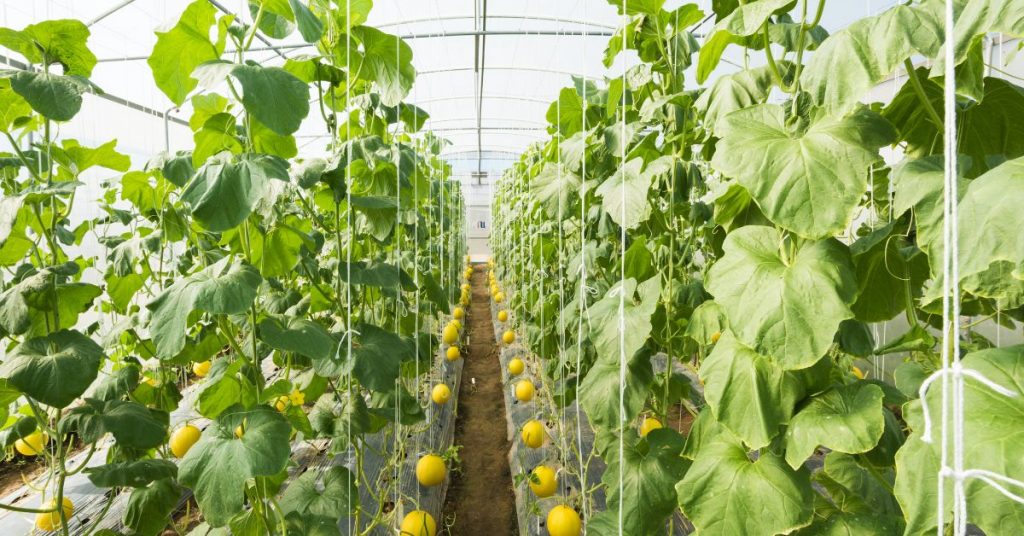
Benefits of Greenhouses and High Tunnels
1. Extended Growing Season
One of the primary benefits of greenhouses and high tunnels is their ability to extend the growing season. These structures create a microclimate that can maintain higher temperatures than the outside environment, allowing urban farmers to start planting earlier in the spring and continue harvesting later into the fall and even winter. This extended growing period is crucial for urban farmers who want to maximize their crop yield and ensure a consistent supply of fresh produce.
2. Protection from Weather Extremes
Urban farming often faces challenges from unpredictable weather patterns, including heavy rain, strong winds, and temperature fluctuations. Greenhouses and high tunnels provide a protective barrier that shields plants from these adverse conditions. By controlling the environment, farmers can reduce the risk of crop damage and loss, leading to more reliable and productive harvests.
3. Enhanced Plant Growth
Greenhouses and high tunnels create optimal growing conditions by maintaining consistent temperatures, humidity levels, and light exposure. This controlled environment promotes faster and healthier plant growth. Additionally, these structures can help protect plants from pests and diseases, further improving crop quality and yield.
4. Efficient Space Utilization
In urban settings where space is often limited, greenhouses and high tunnels allow farmers to make the most of their available area. These structures can be installed on rooftops, in backyards, or on vacant lots, turning otherwise unused spaces into productive urban farms. Vertical growing systems and multi-tiered planting arrangements within greenhouses and high tunnels can further maximize space efficiency.
Implementation Strategies
1. Choosing the Right Structure
Selecting the appropriate greenhouse or high tunnel depends on several factors, including space availability, budget, and specific gardening needs. Greenhouses are typically more permanent structures with rigid frames and transparent walls made of glass or polycarbonate. High tunnels, also known as hoop houses, are simpler and more flexible, featuring metal or plastic frames covered with polyethylene film. Both types of structures offer significant benefits, but high tunnels are often more affordable and easier to install, making them a popular choice for urban farmers.
2. Energy-Efficient Materials
To maintain optimal growing conditions, it’s essential to use energy-efficient materials and systems in your greenhouse or high tunnel. Polycarbonate panels or double-layer polyethylene films provide excellent insulation, helping to retain heat and reduce energy costs. Additionally, installing thermal screens or insulating curtains can further enhance energy efficiency by trapping heat during the night and blocking excessive sunlight during the day.
3. Ventilation Systems
Proper ventilation is crucial to prevent overheating and maintain a healthy growing environment inside greenhouses and high tunnels. Installing ventilation systems, such as roof vents, side vents, and exhaust fans, can help regulate temperature and humidity levels. Automated ventilation systems can be particularly beneficial, as they adjust airflow based on real-time environmental conditions, ensuring that plants receive the optimal amount of fresh air.
4. Irrigation and Water Management
Efficient water management is essential in controlled growing environments. Drip irrigation systems and automated watering schedules can ensure that plants receive consistent moisture without overwatering, which can lead to root rot and other issues. Additionally, incorporating rainwater harvesting systems can provide a sustainable water source for your greenhouse or high tunnel, reducing dependency on municipal water supplies.
Greenhouses and high tunnels offer versatile and effective gardening solutions for urban farmers. By extending the growing season, protecting crops from weather extremes, and enhancing plant growth, these structures can significantly improve urban farming outcomes. When equipped with energy-efficient materials, proper ventilation, and efficient water management systems, greenhouses and high tunnels become invaluable tools in the quest for sustainable urban agriculture. Embracing these solutions can help urban farmers maximize their productivity, contribute to local food security, and create greener, more resilient cities.
9. Composting
Composting is an excellent gardening solution for urban farmers. It transforms kitchen scraps and garden waste into nutrient-rich compost that enhances soil health and fertility. In urban environments, where waste management and sustainable practices are crucial, composting offers a way to reduce waste while providing a valuable resource for your garden.

Benefits of Composting
1. Soil Improvement
Compost is a rich source of organic matter that improves soil structure, aeration, and water retention. It enhances the soil’s ability to hold nutrients, making them more available to plants. This results in healthier plant growth and higher yields. Urban farmers can greatly benefit from using compost to rejuvenate poor or depleted soils often found in city environments.
2. Waste Reduction
Composting helps reduce the amount of organic waste sent to landfills. Food scraps and garden waste make up a significant portion of household waste, and composting these materials can divert them from the waste stream. This not only reduces the environmental impact but also creates a useful product from what would otherwise be discarded.
3. Environmental Benefits
Composting reduces greenhouse gas emissions from landfills, where organic waste would otherwise decompose anaerobically and produce methane, a potent greenhouse gas. By composting, urban farmers contribute to lowering their carbon footprint and promoting a more sustainable urban environment.
How to Compost in Urban Settings
1. Choose a Composting System
For urban farmers, space-efficient composting systems are essential. Two popular options are compost bins and tumblers:
- Compost Bins: These can be stationary units placed in a corner of your yard or garden. They are ideal for continuous composting and can handle a variety of organic waste materials.
- Compost Tumblers: These are enclosed units that can be rotated to mix the composting materials. Tumblers speed up the decomposition process and are convenient for small spaces like balconies or patios.
2. Materials to Compost
To create effective compost, a balance of “green” and “brown” materials is needed:
- Green Materials: These are high in nitrogen and include kitchen scraps like fruit and vegetable peels, coffee grounds, and fresh grass clippings.
- Brown Materials: These are high in carbon and include dried leaves, straw, cardboard, and paper.
A good rule of thumb is to maintain a ratio of roughly 3 parts brown materials to 1 part green materials.
3. Composting Process
- Layering: Start with a layer of coarse materials like twigs or straw to provide aeration. Alternate layers of green and brown materials.
- Moisture: Keep the compost pile moist, similar to a damp sponge. Too much water can cause anaerobic conditions, while too little will slow down decomposition.
- Aeration: Turn the compost regularly to introduce oxygen, which speeds up the decomposition process and prevents odor.
4. Using the Compost
Once the compost has broken down into a dark, crumbly, and earthy-smelling material, it is ready to use. Incorporate it into your garden soil to improve fertility, spread it as mulch to retain moisture, or use it to make compost tea, a nutrient-rich liquid fertilizer.
Tips for Urban Composting
1. Manage Small Spaces
Urban farmers often have limited space, so consider vertical composting systems or stackable compost bins that fit in tight areas. Tumblers are particularly effective for small spaces because they contain the compost and minimize odors.
2. Speed Up Decomposition
To accelerate the composting process, chop or shred larger materials before adding them to the bin. This increases the surface area and helps microorganisms break down the materials more quickly.
3. Avoid Common Mistakes
Avoid adding meat, dairy, or oily foods to your compost as they can attract pests and create unpleasant odors. Stick to plant-based kitchen scraps and garden waste for the best results.
By implementing composting as a gardening solution for urban farmers, you can create a sustainable and productive garden. Composting not only enhances soil health and plant growth but also contributes to waste reduction and environmental sustainability. Embrace composting to turn your urban farm into a model of green living and sustainable agriculture.
10. AiFarming
AiFarming integrates artificial intelligence (AI) and machine learning (ML) technologies into agriculture to enhance various farming practices. This approach leverages advanced data analytics, remote sensing, and automation to improve efficiency, productivity, and sustainability in farming. AiFarming encompasses a wide range of applications, from precision agriculture to smart irrigation systems, and from crop monitoring to automated harvesting.
Benefits of AiFarming
- Enhanced Productivity and Yield:
Precision Agriculture: AiFarming enables precision agriculture, where AI-driven tools analyze soil conditions, weather patterns, and crop health to optimize planting schedules and resource usage. This precision leads to higher crop yields and better resource management.
Data-Driven Decisions: By collecting and analyzing data from various sources such as satellite imagery, drones, and sensors, farmers can make informed decisions that enhance crop management and productivity.
- Resource Optimization:
Efficient Water Use: Smart irrigation systems use AI to monitor soil moisture levels and weather forecasts, ensuring crops receive the right amount of water at the right time. This reduces water waste and improves crop health.
Optimized Fertilizer Application: AI tools analyze soil nutrient levels and recommend precise fertilizer application, reducing the overuse of fertilizers and minimizing environmental impact.
- Cost Reduction:
Reduced Labor Costs: Automation in farming, such as the use of AI-powered robots for planting, weeding, and harvesting, reduces the need for manual labor. This not only cuts labor costs but also addresses labor shortages in the agricultural sector.
Pest and Disease Management: AI systems can detect early signs of pests and diseases through image recognition and predictive analytics. Early detection allows for timely intervention, reducing crop loss and minimizing the use of pesticides.
- Sustainability and Environmental Protection
Minimized Environmental Impact: Precision farming practices reduce the overuse of water, fertilizers, and pesticides, leading to lower environmental pollution and soil degradation. This promotes sustainable farming practices that protect natural resources.
Biodiversity Preservation: AI-driven farming practices can promote biodiversity by optimizing crop rotation and mixed cropping strategies, which enhance soil health and reduce the need for chemical inputs.
- Improved Crop Monitoring and Management
Real-Time Monitoring: AI tools provide real-time monitoring of crop health, soil conditions, and weather patterns. This continuous monitoring helps farmers respond promptly to any issues that may arise, ensuring optimal crop growth.
Yield Prediction: AI algorithms analyze historical data and current conditions to predict crop yields accurately. This helps farmers plan their harvests and manage their supply chains more effectively.
- Market and Supply Chain Efficiency
Market Analysis: AI can analyze market trends and consumer demand, helping farmers decide which crops to plant and when to sell them for the best prices. This reduces market risks and enhances profitability.
Supply Chain Management: AI tools can optimize supply chain logistics, from harvesting to storage and transportation, ensuring that produce reaches the market in the best condition and with minimal waste.
Urban farming offers a sustainable and efficient way to produce fresh, local food in densely populated areas. By leveraging innovative gardening solutions such as container gardening, raised bed gardens, rooftop gardening, hydroponics, aquaponics, and vertical gardening, urban farmers can maximize limited spaces and improve productivity. Community gardens foster collaboration and shared resources, while urban beekeeping supports pollination and biodiversity. Composting enhances soil health and reduces waste, while smart gardening technology optimizes resource use and automates tasks. Embracing these techniques can transform urban environments into thriving agricultural hubs, promoting food security, sustainability, and community well-being. Urban farming is a viable and impactful approach to addressing the challenges of food security and sustainability in cities, making it a crucial component of modern urban living.




